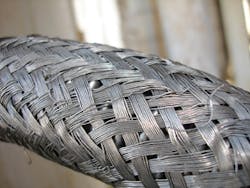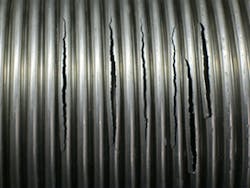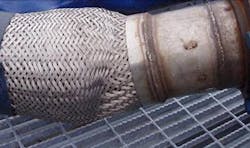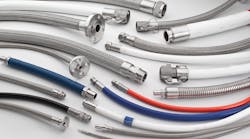Frank Caprio is Hose Master’s corporate trainer, major market specialist, and dean of hose master university. Mr. Caprio has more than 35 years of experience in hydraulic, industrial and metal hose and expansion joint products and their applications. Frank is a member of NAHAD, AIST, ASME, and ASM International.
Q: For what sort of fluid handling applications is metal hose generally a good fit?
A: Corrugated metal hose is ideal for use in applications where extremely high or low temperatures (either internal or surrounding the hose) are encountered. Corrugated metal hose is used for steam transfer, high-heat environments, such as steel mills and furnaces, as well as for the transfer of cryogenic liquids. Corrugated metal hoses are used in critical fire-safety applications, such as fire sprinkler systems, flexible connectors for piping on underground gasoline storage tanks, and barge loading/unloading systems.
Corrugated metal hose is also a good choice for applications where corrosion is a concern, whether from corrosive media or environments. The hose and outer wire braid can be made using various alloys to suit corrosive applications, such as those found in refineries and chemical plants.
The geometry of the corrugations gives metal hose excellent hoop strength, providing superior resistance to collapse in vacuum applications or when exposed to high external pressures, such as those found in autoclave or deep sea applications. Corrugated metal hose does not permit permeation of the media through the hose wall, as do nonmetallic constructions, which is an important characteristic in applications where corrosive or combustible media are being conveyed, or where high vacuum levels must be maintained.
Corrugated metal hoses offer flexibility in end fitting configuration, as they are able to accept a wide variety of end fittings in complex arrangements. Virtually any metal fitting that can be welded or brazed can be incorporated into a corrugated metal hose assembly. Also, corrugated metal hoses permit the direct attachment of special or customer-specific fittings and flanges. A metallic hose with welded fittings is also electrically conductive, preventing the buildup of static electricity. Nonmetallic hoses may require special construction or fabrication techniques to ensure electrical continuity. In addition, corrugated metal hose is used in tight installations, as the end fittings are typically more compact than barbed fittings used on nonmetallic hoses. Shorter fitting lengths allow for longer “live” hose lengths per assembly, maximizing flexibility.
Q: For what sort of applications is metal hose generally not a good fit?
A: Because metal hose is constructed from welded components, it should not be used for the transfer of food or medical grade materials. The welded hose-to-fitting connections have the potential to harbor bacterial growth, which may contaminate the media. Also, a corrugated metal hose is not resistant to abrasive media unless fitted with a flexible, abrasion-resistant interlocked hose liner.
Q: What are some key considerations an end-user should make to ensure the appropriate hose is specified for the application?
A: The Acronym STAMPED is a useful tool to determine the best hose for an application:
S = Size of the hose – inner diameter and length.
T = Temperature – Internal and external to the hose.
A = Application – in what position is the hose installed, and how does it move? Is there vibration present?
M = Media – To what chemicals is the assembly exposed, both internally and externally?
P = Pressure – What is the maximum operating pressure of the application? Are there any pressure spikes or pulsating pressures present?
E = End fittings – What are the mating connections (including style, alloy and size)?
D = Dynamics – What are the flow dynamics of the application? Since corrugated metal hose does not have a smooth interior, special fabrication options may be required to prevent excessive flow velocities from inducing resonant vibration, which can lead to premature fatigue and failure of the metal hose.
Q: Regarding material selection, how can end-users best ensure they are specifying the appropriate alloy for their metal hose application?
A: We recommend that our customers contact us with any questions regarding alloy selection. Because corrugated metal hose is formed out of thin-walled tubing, it must be chemically resistant to the media to which it will be exposed. It is important to know the temperature and concentration of the chemical being transferred, as these variables can significantly affect the corrosion rate. We rely on several corrosion-resistance databases, including data published by NACE (National Association of Corrosion Engineers). The use of corrosion-resistance charts published by manufacturers of piping components, such as pipe fittings, flanges, etc., is not recommended for corrugated metal hose; these other piping components generally have much heavier wall thicknesses than corrugated metal hose, and therefore may have allowable corrosion rates that would be unacceptable for the hose.
Q: Why is it important for end-users to consider the effects of pressure, temperature, vibration, and flow velocity when specifying a hose?
A: Ignoring any one of these variables can dramatically affect the performance of any hose assembly, including corrugated metal hose. First, metals get softer as temperatures increase, and at different rates depending on the alloy. It is important to apply the proper pressure-derating factor when using metal hose at elevated temperatures. Second, dynamic pressures (spikes, surges, pulsations, etc.) can accelerate metal fatigue in the corrugations, so there are additional derating factors to account for these stresses. Third, vibration (either mechanical or velocity-induced) may contribute to metal fatigue if not taken into account. For the experienced hose manufacturer, there are numerous ways to mitigate the effects of these variables – through proper alloy selection, by applying the appropriate pressure derating factors, by adding accessory items to the assembly, or by employing specialized fabrication techniques.
Corrosion and metal fatigue are the two most common modes of failure for a corrugated metal hose. Corrosion can be addressed through proper alloy selection. Metal fatigue, however, is more difficult to identify and prevent. All metals will eventually fatigue when subjected to stress, which may result from over-bending the hose, vibration, chemical attack (Stress Corrosion Cracking), substandard fabrication, or from inferior hose manufacturing methods. Not all corrugated metal hoses are created equal, despite efforts by some manufacturers to treat hose as a commodity item. Work with experienced factory personnel who are trained to identify and solve issues relating to hose assembly, longevity and safety. They will help to maximize the value of the product rather than selling it solely by price.
Q: How can end-users determine the optimal length of their hose assembly?
A: We recommend using the length calculation formulas published by NAHAD (The Association for Hose and Accessories Distribution) in their Corrugated Metal Hose Design Guide #400. These length calculation formulas help users determine the proper assembly length for all common hose installations (travelling hose loops, angular movement, lateral offsets, etc.). We also reference these formulas on our company website. If an installation does not fit into one of these categories, a trained hose specialist may be required to offer application engineering assistance.
Q: What are the typical failure modes of a hose assembly, and how can an end-user best ensure early identification of these failure modes?
A: Any of the following signs should warn the user to remove the assembly from service immediately:
-
Corrosion of a corrugated metal hose can be spotted by looking for signs of chemical residue on the exterior of the assembly, or by pitting of the metal hose wall. The braid wires may become discolored from chemical attack and begin to fracture.
-
Metal fatigue can be caused by several factors, and each failure mode can provide clues for identifying the source of the fatigue. We recommend that any failed assembly should have a detailed analysis performed in order to correctly identify the mode of failure. An improperly trained technician may not only draw an incorrect conclusion when conducting an analysis, it is possible that vital evidence may be destroyed if the assembly is not analyzed using a consistent and proven methodology.
-
Over-bending a corrugated metal hose assembly is often evidenced by a bulging of the outer braid, typically located directly behind the end fitting. When the corrugations of the hose are subjected to bending stresses beyond their designed limits, the metal plastically deforms and rapidly fatigues. Hoses that have been over-bent frequently exhibit a swollen corrugation profile, which can be mistaken for over-pressurization of the assembly if not analyzed correctly.
-
Vibration-induced fatigue creates branched fractures running through the metal in different directions, whereas excessive cycling of an assembly can create parallel fatigue fractures much like waves upon a beach, which propagate through the hose wall. Again, a detailed analysis conducted by a trained technician is recommended to ensure proper identification of the failure mode.
This is the first part of a two-part Q&A based on the content of the Hose Master University training, which focuses on applications and best practices for specifying flexible metal hose and expansion joints for fluid handling scenarios. Part II of this Q&A, which will focus on expansion joints, will appear in the May issue.






